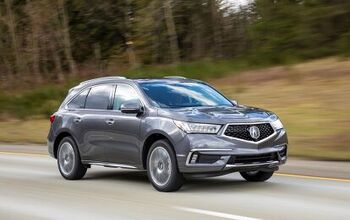Toyota RAV4 Hybrid Vs Honda CR-V Hybrid Comparison


It’s hard to overstate just how important the battle of the 2023 Toyota RAV4 Hybrid vs 2023 Honda CR-V Hybrid is.
Last year, Honda sold 238,155 CR-V models in America alone. Not too bad for a year rife with inventory shortages. That makes the CR-V the 7th most-sold vehicle in America. For Toyota, the news is even better. The brand was able to deliver 399,941 RAV4s to American customers in the same year, making it the 4th best-selling vehicle.

The secret to the success of these two small SUVs is value and choice. Both auto manufacturers offer plenty of configurations, at price points that fit the wants and needs of many families. Some of the more popular choices amongst consumers are the hybrids.
Toyota has a long history of producing hybrid versions of the brand’s core models, like the RAV4. All new a few years ago, the current RAV4 Hybrid includes good power and great efficiency. Honda also has a history of adapting hybrid technology to the CR-V. This year, the compact SUV is all-new, which means there’s an equally new CR-V Hybrid.

To see which top-selling compact SUV hybrid is best, we gathered a pair for a head-to-head competition. From Honda, we have the top-of-the-line CR-V Sport Touring Hybrid. From Toyota, it’s the new for 2023 RAV4 Hybrid Woodland Edition.
After a week of driving, testing, comparing, and evaluating, we gathered up our thoughts and declared a winner. Read on to see how the results played out.
Styling

Honda CR-V Hybrid: The new generation Honda CR-V is a big departure from last year’s model. We really like the new exterior design. It’s not often a vehicle improves looks-wise this much generation over generation, but the new CR-V is one of those rare cases.
It wears black 19 inch wheels on the Sort Touring Hybrid. At the back, there are dual exhaust finishers, but only one side has an actual exhaust running through it. Up front, there’s a long flat hood that ends at a nearly vertical grille. As is all the rage these days, the headlights are long and narrow. Also, the CR-V features lower chrome accents, or nostrils as we like to call them. This too seems to be a styling trend in the industry right now.

Toyota RAV4 Hybrid: The Woodland RAV4 sits noticeably higher than the CR-V. Although the TRD-tuned suspension isn’t listed as having any extra ground clearance, the Woodland Edition visually looks more lifted off the ground.
We do like the look of the new RAV4. It rivals the CR-V in terms of how much better this generation looks compared to the awkward previous generation. The RAV4 features boxy styling that makes it look more SUV than crossover. In the rear, it has a dual exhaust set up as well.

Bottom Line: We do prefer the overall look of the CR-V. The sophisticated, understated new styling gives a premium aura to the SUV. But there’s no contest when it comes to the wheels. The RAV4 Woodland’s bronze wheels look great. They really standout compared to the ho-hum black wheels on the CR-V.
For this category, we still give the edge to the Honda CR-V Hybrid’s overall looks.
Interior Design

Honda CR-V Hybrid: Inside, the new Honda CR-V feels modern, but with a minimalist design. All the HVAC and steering wheel controls are logically placed and easy to use. We still like the full-length honeycomb air vent finish that’s prevalent in most Honda products now.
The front seats are comfortable, featuring a pleasing look and design. There are good sight-lines throughout the vehicle, with minimal blindspots. The programable digital dash is easy enough to set-up and has all the information we need right at hand.

Toyota RAV4 Hybrid: The interior of the RAV4 is not as premium looking as that of the Honda CR-V, and it’s not just because of the mid-level Woodland trim we have on hand. Even loaded up versions of the RAV4 lack some of the richer materials found in the Honda.
That stated, the Toyota’s interior is more functional. We like the large knobs, buttons, and switches that all seem logically placed. Is it a bit dated of a design? Yeah, it is. But there’s a reason it has lasted so long – it simple to operate and works. Less appealing to us is the material used inside all of the storage shelfs, nooks, and crannies. The polished plastic offers no grip and items just slide around.

Bottom Line: The Toyota RAV4 has the more functional interior by a small margin. But the more premium interior in the CR-V gives it the edge in this category.
Passenger and Cargo Space

Honda CR-V Hybrid: Front and rear seat passengers get 38.2 inches (970 mm) of headroom. Legroom is generous all around, with front row occupants having 41.3 inches (1,049 mm) and those seated in the rear with 41.0 inches (1,042 mm). Our six-foot tall tester finds there to be plenty of headroom and legroom in the rear seat. He also likes that the arm rests are well placed and padded all around.
The CR-V has a slight cargo carrying advantage, with 39.3 cu ft. (1,028 L) of space behind the rear seats, and 76.5 cu ft. (2,030 L) when the seat backs are folded flat. We had no issue loading an adult bike into the rear hatch of the vehicle.

Toyota RAV4 Hybrid: Interior space looks more cramped on paper, as the RAV4 Hybrid only offers 41.0-inches (1,031 mm) of front legroom, and 37.8-inches (960 mm) for those in the rear. Headroom up front is listed at a scant 37.7-inches (991 mm), but cranium capacity for rear seat passengers is more generous at 39.5-inches (1.016 mm).
In actual use, both front and back seats of the Toyota feel just as spacious as those in the Honda. We can notice the backseat’s extra headroom and there’s still plenty of legroom for six-foot passengers. The arm rests are well placed and padded all around. The only negative is there’s a slight dip in the roof liner right in front of the rear row.
Cargo capacity is a similar story, as the RAV4 offers less capacity with 37.6 cu ft. (1,059 L) when the seats are up, or 69.8 cu ft. (1,977 L) when they are folded down. But the large rear hatch opens further up the roofline, creating a bit of a clamshell opening. It makes loading and unloading large items, like a bicycle, easier.

Bottom Line: Both vehicles are very accommodating, which is no surprise. There’s a reason they’re so popular. Usable space between the two is a tie.
Tech and Features

Honda CR-V Hybrid: Even though the vehicle is all-new, the infotainment system in the Honda CR-V Hybrid looks outdated. The largest screen available is 9.0-inches which, as crazy as it sounds, is getting small by today’s standards. The navigation system is equally mediocre and seems a generation or two old.
On the plus side, although there are very few hard buttons to control the infotainment system, it’s easy enough to use. There is a volume knob and tuner buttons, which helps with basic controls.

Toyota RAV4 Hybrid: The RAV4 Hybrid’s infotainment system is more modern looking, running through a 10.5-inch screen. Prominently touchscreen-controlled, it lacks any physical controls other than a volume knob. The absence of a tuner dial/button makes navigating various functions, especially changing radio stations, an absolute chore.
The RAV4 has better sounding audio system and the navigation system is slightly above average.

Bottom Line: Both vehicles come with all the latest safety technology, as is expected for the segment. Fully loaded, the RAV4 Hybrid and CR-V Hybrid can be equipped with rain sensing windshield wipers, a hands-free tailgate, a wireless phone charger, ambient lighting, and more.
The CR-V includes some cool tricks like a rear camera washer, and wet wipers up front. The RAV4 counters with an optional digital rear-view mirror. Once again, we have a back-and-forth affair in this category that does not provide a clear-cut victor.
Powertrain and Efficiency

Honda CR-V Hybrid: Powering hybrid versions of the CR-V is a 2.0-liter four-cylinder that pairs to a set of electric motors. On its own, the gas engine produces 145 hp, and 138 lb-ft. of torque. The traction motor generates 181 hp, while the generator motor makes 161 hp. In total, the system produces 204 hp and 247 lb-ft. of torque. Power is sent to all four wheels through an e-CVT.
The engine is noticeably quieter in the CR-V compared to the RAV4. The hybrid does a good job seamlessly transitioning through the various drive modes. The engine revving freely unrelated to vehicle speed does take some getting used to – a by-product of the hybrid system.

Around town, the CR-V Hybrid feels a bit slower than the numbers suggest. When accelerating up to highway speeds though, power is more apparent. The vehicle easily gets to legal freeway speeds and wants to continue beyond.
Officially, the CR-V Hybrid is rated at 40 mpg (6.0 L/100 km) in the city, and 34 mpg (6.9 L/100 km) on the highway. During our drive loop, we saw an average of 32.2 mpg (7.3 L/100 km).

Toyota RAV4 Hybrid: Under the hood of the RAV4 is a 2.5-liter four-cylinder engine making 176 hp. It partners up with two electric motors, one up front making 118 hp, and one in the rear producing 149 hp. All told, total system output is pegged at 219 hp – more than the CR-V.
The RAV4’s drivetrain as a whole is louder. It’s not just the engine, but also the hybrid system. We can hear a subtle whining as it builds and decreases speed. It’s just as smooth as the system found in the CR-V though; and it makes more power. At all vehicle speeds, the RAV4 feels quicker and more responsive. The advantage around town is more noticeable, as the power gap is less apparent at highway speeds.
Officially, regular versions of the RAV4 Hybrid have an efficiency advantage over the CR-V. Ratings are listed as 41 mpg (5.8 L/100 km) city, and 38 mpg (6.3 L/100 km) highway. With the Woodland Edition and its all-terrain tires, those figures drop to 38 mpg (6.2 L/100 km) city, and 35 mpg (6.7 L/100 km) highway. Still, during out driving loop, we saw an impressive 35.6 mpg (6.6 L/100 km) average.

Bottom Line: This category is a bit clearer cut than previous ones. Despite a slightly quieter operation, the Honda CR-V Hybrid cannot match the RAV4’s power or efficiency. Toyota takes the win here.
Handling and Ride Comfort

Honda CR-V Hybrid: The all-new CR-V Hybrid feels more solid and reinforced. There’s less perceived body flex over bumps compared to the older model. It’s quieter inside as well, eliminating a lot of wind and road noise. All we really hear is the rumble from the knobby winter tires.
The hybrid handles well enough for its class. It’s not one of the more engaging vehicles to drive, but also not wobbly or sloppy when cornering. The steering is a bit firmer, with a hint more feedback than the RAV4. All-in-all the new CR-V is just an easy vehicle to drive.
But best of all may be its great ride quality. The suspension swallows up bumps well. The CR-V rarely gets upset nor allows many vibrations up into the cabin.

Toyota RAV4 Hybrid: The RAV4 also feels structurally solid, not allowing much chassis flex over undulating road surfaces. Ride comfort isn’t as smooth, as more bumps are felt throughout the cabin. More vibrations make their way inside as well.
This isn’t really a knock against the Toyota though. It isn’t exactly choppy, buzzy, or uncomfortable inside the RAV4. The vehicle just doesn’t do as terrific a job isolating passengers as the CR-V Hybrid does.
When it comes to cornering responses though, the pendulum swings back in the RAV4’s favor. It’s more eager to change directions and the rear-end is livelier. The RAV4 feels lighter on its feet, which makes sense as it has a small weight advantage, weighing 3,775 lbs. (1,700 kg) versus the CR-V at 3,926 lbs. (1,785 kg).

Bottom Line: This is a more decisive win for the Honda CR-V Hybrid. It has a more comfortable and quiet driving experience, while giving up very little in terms of vehicle response.
Pricing and Value

Honda CR-V Hybrid: In the United States, there are five basic trims of CR-V. The two entry level trims come with the gas engine. The middle trim, called the Sport Hybrid, gets the hybrid drivetrain. Second from the top is the EX-L which reverts to pure gasoline power. Sitting atop the CR-V hierarchy is the Sport Touring Hybrid, which is the model we have on hand.
Pricing starts at $34,245 for the Sport Hybrid (all prices include destination charges), with our as tested Sport Touring Hybrid coming in at $40,850.
In Canada, only one trim of Hybrid is available, the top-of-the-line fully loaded Touring Hybrid. It has a starting price of $50,840, which increase to $51,140 as tested thanks to the Canyon River Blue Metallic exterior paint.

Toyota RAV4 Hybrid: The Toyota RAV4 Hybrid offers a lot of more trim level options; seven to be exact. The entry level LE Hybrid begins at a price of $32,060. Our mid-level Woodland Edition Hybrid came in at $34,860. For a better apples to apples comparison against the CR-V Sport Touring Hybrid, the full loaded RAV4 Limited Hybrid comes in at $43,330 with all optional packages included.
In Canada, there is a decisive price advantage for the RAV4 Hybrid, as the LE begins at a price of $36,780. The Woodland Edition as tested comes in at $42,110 while a top-of-the-line RAV4 Hybrid is listed at $48,035.

Bottom Line: Pricing for comparative models of these SUVs is close. But Toyota offers an addition five trims of RAV4 with the Hybrid drivetrain compared to the CR-V. What’s more, some of these RAV4 trims include additional options packages. This gives consumers much more choice, and a cheaper entry point into the Hybrid RAV4. The advantage here goes to Toyota.
Toyota RAV4 Hybrid vs Honda CR-V Hybrid: Verdict

Neither vehicle in this comparison may be exciting to drive. but both work very well at their intended goal as compact SUVs. Each have their strengths and weaknesses. The Honda CR-V Hybrid is the better overall SUV, with a more premium feel inside, better ride comfort, and a quieter driving experience.
The Toyota RAV4 is the better hybrid. It offers more usable power in every situation and handily beat the CR-V’s fuel economy on our driving loop. There's also a lot more choice from Toyota when it comes hybrid versions of this compact SUV.
As has been the case, we expect more folks will find a Toyota RAV4 Hybrid that meets their needs. But if one of the Honda CR-V Hybrid models does fit your budget and lifestyle, we wholly recommend it as it’s a better all around vehicle, and our pick in this comparison.
Toyota RAV4 Hybrid Woodland Edition Gallery
Honda CR-V Hybrid Sport Touring Gallery
Become an AutoGuide insider. Get the latest from the automotive world first by subscribing to our newsletter here.

A 20+ year industry veteran, Mike rejoins the AutoGuide team as the Managing Editor. He started his career at a young age working at dealerships, car rentals, and used car advertisers. He then found his true passion, automotive writing. After contributing to multiple websites for several years, he spent the next six years working at the head office of an automotive OEM, before returning back to the field he loves. He is a member of the Automobile Journalists Association of Canada (AJAC), and Midwest Automotive Media Association (MAMA). He's the recipient of a feature writing of the year award and multiple video of the year awards.
More by Mike Schlee











































Comments
Join the conversation
I dont think that there is ONE Comparison test where you choose a Toyota as your pick. I guess you do not like Quality just plastic crap
You omit the torque rating of the RAV 4, so how is a consumer supposed to truly compare specs when you leave out important info?